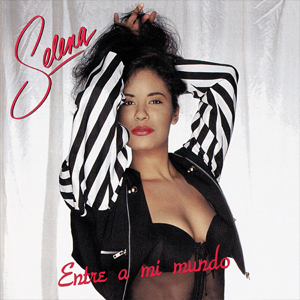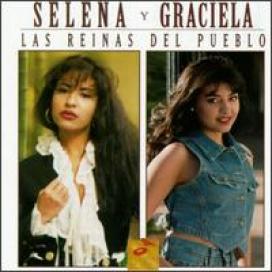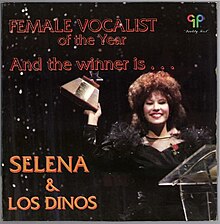
Selena Quintanilla Pérez was an American singer. Referred to as the "Queen of Tejano Music", her contributions to music and fashion made her one of the most celebrated Mexican-American entertainers of the late 20th century. In 2020, Billboard magazine put her in third place on their list of "Greatest Latino Artists of All Time", based on both Latin albums and Latin songs chart. Media outlets called her the "Tejano Madonna" for her clothing choices. She also ranks among the most influential Latin artists of all time and is credited for catapulting the Tejano genre into the mainstream market.

Entre a Mi Mundo is the third studio album by American singer Selena, released on May 6, 1992, by EMI Latin. The label endeavored to bolster Selena's popularity within the Latin music market in the United States with this release. Selena's brother, A. B. Quintanilla kept his role as the singer's producer and, in collaboration with Selena y Los Dinos members Pete Astudillo and Ricky Vela, composed tracks for the album. The ensuing recording encompassed an eclectic array of songs, attributable to the members' diverse backgrounds, which facilitated the modernization of the many genres they explored. Entre a Mi Mundo is a Tejano cumbia album that encapsulated Selena's quintessential sound, characterized by engaging tunes harmonized with her distinctive, plaintive vocals and a relaxed, danceable cumbia beat. The album incorporates musical inspirations from power pop, R&B, disco, rock, funk, and synthesized Tejano music.

Selena is the debut studio album by American Tejano singer Selena, released on October 17, 1989, by EMI Latin. Its music incorporates a range of contemporary genres with a mix of cumbia and regional styles of Mexican music. The album was released following company president Jose Behar's failed crossover request for the singer. The project was denied by the heads of EMI Records' pop division, believing the singer should first strengthen her fanbase. Selena's brother and principal record producer and songwriter, A.B. Quintanilla III fought to remain the singer's producer. The band introduced Pete Astudillo and Joe Ojeda, who contributed to the album's experimental production and songwriting. Aside from A.B., Selena worked with two Mexican songwriters, Alejandro Montealegre and Reinaldo Ornelas.

Live! or Selena Live! is a live album by American Tejano pop singer Selena, which was released on May 4, 1993, by EMI Latin. The album was re-released on September 22, 2002, as being part of the Selena: 20 Years of Music collection; which included spoken liner notes by her family, friends and her former band members Selena y Los Dinos. Live! includes three cumbia-influenced studio tracks, while the rest of the album consists of live versions of previously released songs. The album was recorded during a free concert at the Memorial Coliseum in Corpus Christi, Texas, on February 7, 1993. It was certified gold by the Recording Industry Association of America in its first year, double platinum in 1995, and 8× platinum in 2017.

Alpha is the second independent studio album by American Tejano music group Selena y Los Dinos. Released on June 11, 1986 under Manny Guerra's G.P. Productions, it followed the group’s debut album, which was recorded under Freddie Records. Selena y Los Dinos, led by vocalist Selena, recorded mostly cover songs. Wanting to stand out, bassist A.B. Quintanilla requested original material from Luis Silva after noticing his track record for writing award-winning songs. Silva ignored A.B.'s request and he was inspired by Abraham to write songs himself. The group expanded to include keyboardist Ricky Vela and guitarist Roger Garcia. Vela collaborated with A.B. on "Dame un Beso", while he collaborated with Abraham on "Dame Tu Amor". A.B. became Selena y Los Dinos' music producer and songwriter, while Abraham encouraged them to record songs of various genres to appeal to a wider audience. Despite her limited Spanish, Selena recorded all nine tracks phonetically.

Mis Mejores Canciones – 17 Super Éxitos is a greatest hits album by American singer Selena released on September 17, 1993, through EMI Latin. Beginning in January 1993, the label released a comprehensive collection that spotlighted its Latin music artists as part of its Latin Classics series. Mis Mejores Canciones – 17 Super Exitos encompasses 17 tracks, ranging from songs recorded on her debut album with EMI Latin, to songs present in Entre a Mi Mundo (1992). The album received a positive response from music critics who enjoyed the label's catalog releases and praised the tracks on the album for showcasing Selena's early popular recordings. Following the shooting death of Selena on March 31, 1995, Mis Mejores Canciones – 17 Super Exitos debuted at number one on the US Billboard Top Catalog Albums chart, the first Spanish-language recording to do so. The Recording Industry Association of America (RIAA) certified the album diamond (Latin), denoting 600,000 units shipped in the United States.

Anthology is the first box set by American singer Selena. It was released posthumously on April 7, 1998, through EMI Latin to commemorate the singer's works. The collection comprises 30 tracks, dispersed across three genre-themed discs: "Pop / English" showcases uptempo pop compositions, "Mariachi" highlights Mexican ballads featuring poignant narratives of heartache, and "Cumbia" presents danceable tropical rhythms. The album encompasses recordings from a 14-year-old Selena on her Alpha (1986) album to the posthumous "Disco Medley" (1997). With a limited number of unaltered tracks, Anthology predominantly features reworked and remastered musical arrangements, while preserving the singer's original vocals. Selena's death in March 1995 prompted an influx of requests from her admirers. The singer's father and manager, Abraham Quintanilla, expressed a desire to maintain his daughter's legacy through her music. However, Selena's family has faced criticism from both fans and the media, who accuse them of capitalizing on her death and commodifying her repertoire.

All My Hits: Todos Mis Éxitos Vol. 2 is a greatest hits album by American singer Selena that was released on February 29, 2000, through EMI Latin. After Selena's murder in 1995, her father Abraham Quintanilla stated his commitment to preserving her music and EMI Latin pledged ongoing support for her releases. In 1999, the label's president José Behar acknowledged Selena, who remained the label's top-selling artist, for her contributions to establishing EMI Latin as "the house that Selena built". In March 1999, to commemorate the label's tenth anniversary, it released All My Hits: Todos Mis Éxitos; it achieved commercial success and a sequel was announced. All My Hits: Todos Mis Éxitos Vol. 2 contains 16 songs ranging from tracks featured on Selena's Muñequito de Trapo (1987) to the posthumous 1997 club remix of "Enamorada de Ti" (1990).

Las Reinas del Pueblo is a compilation album by American Tejano music singer Selena and Mexican banda singer Graciela Beltrán. It was released on April 4, 1995, by EMI Latin in the wake of Selena's death on March 31, 1995. The decision to produce a compilation album featuring Beltrán emerged after her tribute to the singer at a Houston memorial. The title was inspired by Mexican newspapers that referred to Selena as "an artist of the people" during a 1992 press tour in the nation and subsequently dubbed her "La Reina del Pueblo" in the aftermath of her death. Las Reinas del Pueblo encompasses six tracks by Selena and six by Beltrán, encapsulating their respective tenures with EMI Latin. Las Reinas del Pueblo peaked at number four on the US Billboard Top Latin Albums and Regional Mexican Albums chart, both behind other Selena releases. The recording peaked at number 147 on the American Billboard 200 chart. The album peaked at number ten on the Spanish albums chart in 2010. Beltrán's participation in the album yielded substantial promotional and sales enhancements.

"Ámame" is a song by American singer Selena, taken from her third studio album, Entre a Mi Mundo (1992). Selena and Chris Pérez began secretly dating subsequent to Pérez's reintegration into Selena y Los Dinos in the summer of 1991, despite her father's objections. The song was written by Selena and conveys her sentiments towards Pérez as they concealed their liaison from familial scrutiny. Pete Astudillo contributed to the lyrical development of the composition, while A. B. Quintanilla handled production. It was released as the fourth and final single from the album in April 1993.

"¿Qué Creías?" is a song by American singer Selena, taken from her third studio album, Entre a Mi Mundo (1992). It was written by Pete Astudillo and A. B. Quintanilla; the composition was a result of a challenge issued by A. B. to Astudillo to create a song before they arrived in Las Vegas from California. Astudillo drew inspiration from the works of Mexican singer Juan Gabriel, culminating in a mariachi ballad. Selena, in describing the song, avers that it embodies women on a collective scale. It is the singer's torch song and the lyrics elucidate Selena's inflexible stance on refusing to absolve an unfaithful partner. She directly addresses her former lover who had taken her for granted, informing him of her capability to exist without him. Critics acclaimed Selena's emotional vocal range and her poetic expression with a distinctly feminine cadence.

"Como la Flor" is a song recorded by American singer Selena. Written by A. B. Quintanilla and Pete Astudillo, it was released as the second single from her third studio album Entre a Mi Mundo (1992). The song was written by Quintanilla, who was inspired by a family selling illuminated plastic flowers at a concert in Sacramento, California, in 1982. A decade later, Quintanilla was seized with an infectious melody and abruptly dashed out of the shower in a hotel room in Bryan, Texas, to recreate it on a keyboard with Astudillo. He completed the music in just 20 minutes, while Astudillo took another hour to complete the lyrics. "Como la Flor" is an up-tempo, Tejano cumbia torch song that blends tropical cumbia rhythms with hints of reggae and pop music. Its lyrics describe the feelings of a female protagonist addressing her former lover, who abandoned her for another partner. The narrator is uncertain of her ability to love again, while at the same time, wishing her former partner and his new lover the best.

"La Carcacha" is a song recorded by American singer Selena for her third studio album, Entre a Mi Mundo (1992). The song was written by A.B. Quintanilla and Pete Astudillo. It was inspired by a dilapidated car and an experience in which A.B. observed a woman's willingness to court the owner of a luxury car. The song, characterized by its rhythmic melodies and satirical portrayal of life in the barrio, highlights the importance of love and genuine connection over material wealth. It is a Tejano cumbia song that is emblematic of Selena's typical style, while music critics found it to be musically similar to "Baila Esta Cumbia".
"Ya Ves" is a song recorded by American singer Selena on her second studio album Ven Conmigo. The song was written by A. B. Quintanilla and Pete Astudillo. "Ya Ves" was released as the lead single off Ven Conmigo in September 1990 and received critical acclaim from music critics, who recognized its significant contribution to the rise of Selena's popularity across the United States, Mexico, and Latin America. Following the unveiling of the United States Postal Service's commemorative Forever Stamps featuring Selena, "Ya Ves" debuted and peaked at number 20 on the US Billboard Regional Mexican Digital Song Sales chart in April 2011. In 2005, Bobby Pulido performed the song at the Selena ¡Vive! benefit concert.

Abraham Isaac Quintanilla Jr. is an American singer, songwriter, and producer. He is the father of Tejano singer Selena and was her manager throughout her life.

Dulce Amor is the sixth and last independent studio album by Tejano music group Selena y Los Dinos. The album became the final album to be released from RP Records on December 24, 1988. Selena's brother, A.B. Quintanilla III had become the main songwriter. Selena recorded fourteen songs but only released ten. All the songs were recorded in three different recording studios. Dulce Amor helped Selena to be noticed at the 1989 Tejano Music Awards. She was then signed by EMI Latin. This would be the last studio album to be released under “Selena y Los Dinos” as all subsequent albums would be released under “Selena”. The album had only sold over 30,000 copies. It was ordered to be removed from stores by EMI Records.

16 Super Éxitos Originales is a greatest hits album by American singer Selena released on March 3, 1990, through EMI Latin. The label aimed to release a compilation containing recordings by Selena y Los Dinos prior to their contractual agreement in 1989, to illustrate the band's musical progressions up to that point. 16 Super Éxitos Originales encompasses 16 tracks re-recorded under new arrangements, ranging from compositions recorded through Freddie Records in 1983 to the group's Dulce Amor (1988) album. The album received critical acclaim from music critics, who found it to have contained recordings that solidified Selena's status in the Tejano music market and introduced her to a broader audience. The album peaked at number 22 on the US Billboard Regional Mexican Albums chart. EMI Latin posthumously re-issued 16 Super Éxitos Originales under the title Mis Primeros Éxitos on August 13, 2002.

Muñequito de Trapo is the third independent studio album by Tejano music group Selena y Los Dinos. It was released on June 29, 1986 under Manny Guerra's GP Productions. The album was originally intended to be an LP for DJ Promotional use only; however, it was later released on cassette. The album mostly consists of cover songs with very little original material. Tim Baker of Newsweek called the album "A return to the 'oldies-rock & roll' sound of the first album."

Preciosa is the fifth independent studio album by Tejano music group Selena y Los Dinos. It was released on October 10, 1988 under Manny Guerra’s RP Records. Preciosa garnered favorable reception from music critics, with Tim Baker of Newsweek observing the group finally purging their oldie influences from their discography. At the 1989 Tejano music awards, Selena was the finalist for Female Vocalist of the Year. Terco Corazon was nominated for Single of the Year, and A.B was nominated for Songwriter of the Year.


















